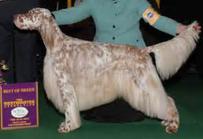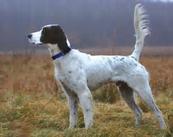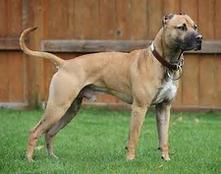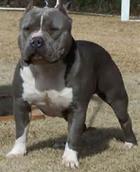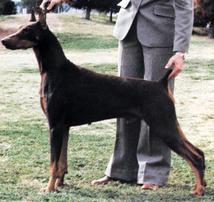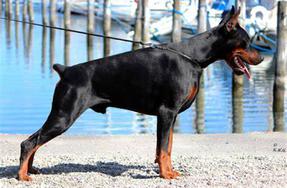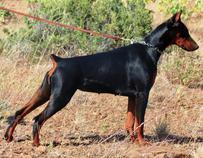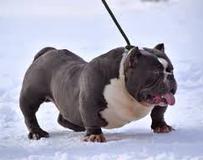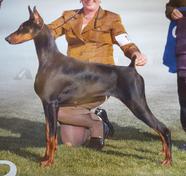DanBar Ranch
European Type And American Type in the Doberman
"Type" refers to those traits, both physical and temperamental, which make each breed unique. Shown a greyhound outline, you would know it was a greyhound, and not a basset hound. Greyhound character is far different from basset hound character. Type refers to appearance AND temperament.
You may be familiar with the fact that some breeds have been "split" into two different "types"; the "working" type and the "show" type.
Here are two dogs, both the same breed - English setter. But one is a dog bred for generations to be a working gun dog (exaggeration of temperament) the other has been bred for generations for exaggeration of physical type - a "show dog".
Same breed - very different types of dog. Each person will find themselves drawn toward one type or the other. Performance - or beauty.
While the Doberman was developed as a working guard dog, unfortunately their noble appearance immediately attracted the attention of the dog show crowd. It has been a curse to the breed that it has always had more breeders intent on breeding for physical beauty rather than utility. This is why today Dobermans are rarely seen as war or police dogs - jobs they were not only the only breed specifically developed for, but which they also were once supreme.
It is the curse of the breed to be so beautiful. In their quest to make Dobermans more and more "elegant", show breeders knowing nothing of the physical attributes a working police/war dog needed, have, and continue, to breed toward type that hampers the animal in its work. Examples being long, thin legs, long thin necks, long, thin muzzles and a lighter, less robust body.
All Dobermans originated in Germany; but from WW2 until the 1980s almost all importations from Europe ceased. Once importations began again the foreign dogs were rarely infused into American lines. For all intents and purposes the Dobermans in Europe and America have been separate populations since 1940. Obviously, differences in type have developed.
Interestingly, while in Europe there has been a very definite split between their working line Dobermans and their show line dogs in the past few decades, in America there has never been enough interest in using the Doberman for work for this population to split. There is no "working line" American Dobermans. All can be considered "show line".
There is a very common misconception that "working" equates to a heavy, bigger dog than a show line dog. Nothing could be further from the truth! In reality in ALL breeds which have a work/show split, the working dog is always smaller and more agile than their show-ring brothers and sisters. This makes sense, as obviously a police K9 needs to be fast, agile and able to jump and run in ways a heavily built, over-sized show line dog cannot. In breeds like the Doberman and Rottweiler, working line dogs run 10 to 20 pounds lighter than show line specimens.
European Show Line Versus American Show Line Dogs
In America EVERY part of the Doberman was lengthened and exaggerated to show "elegance". Long thin head, neck, body, legs, tail and ear crop. Below see a typical European show winning male Doberman (Left) and (Right) a male who was at one time the winningest Doberman in the USA as well as a hugely popular stud. Ch. Marienburg's Sun Hawk shown as a fully mature, six year old dog.
Here I have discussed only the appearance differences. Is there a difference in character as well? Almost without doubt - yes. For the simple reason that European champions must pass WORKING TESTS in order to win the highest levels and become popular breeding dogs. For this reason there does tend to be a much stronger character found in European dogs.
BOTTOM LINE: Look at the two bitches on the right. TOP is my DanBar Darque Energy as a 9 month old pup. She has a strong, functional neck, good bone in strong legs. She could tangle with an intruder and not get hurt. BOTTOM is a bitch that won an award recently at the Doberman Pincher Club of American national specialty. To me she is far too frail to function as an authentic Doberman. I don't find this type attractive. Her thin legs and neck would not stand up to real man-work. If you fancy this type of Doberman, you will not care for my utilitarian bred dogs.
BACK to last page
(Left) 2017 Sieger Ch. Tahi Reme Jedi representing the European Doberman. He is the sire of my imported XDog vom Gerdautal. (Right) is Ch. Marienburg's Sun Hawk, CD, representing the American bred Doberman. If you prefer the dog on the left you will like my dogs. If you prefer the looks of SunHawk (right) you will want an American bred Doberman.
The difference in type should be obvious. One dog is "robust". One dog is "elegant".
Another breed that was "split" into working and show lines is the breed known as "American pit bull" by performance registries and as "American Staffordshire" by the AKC. Dog fighters and hog hunters use American pit bulls while those who want to win dog shows only use the American Staffordshires.
So, the Staffordshire is bred for "extreme type" resulting in excessive bulk, and a shorter, compact body. Fighting dogs who need to be able to wrestle and have stamina for fights lasting up to 4 hours, are thinner and more athletic. Sadly, in the past few decades this fad for exaggerated type has been taken to horrific extremes in the new "breed" called "American Bullies". These are a mix of show bulldog, French bulldog and American Staffordshires. They are bred by people only interested in producing as "extreme" a dog as possible - obviously with NO concern for the health or welfare of the poor animals.
(L) An athletic performance bred American pit bull. (M) A show bred American Staffordshire, showing exaggeration of "stocky" type. (R) Cruelty and no other word for it; an "American Bully" bred to be an extreme version of the American Staffordshire.



